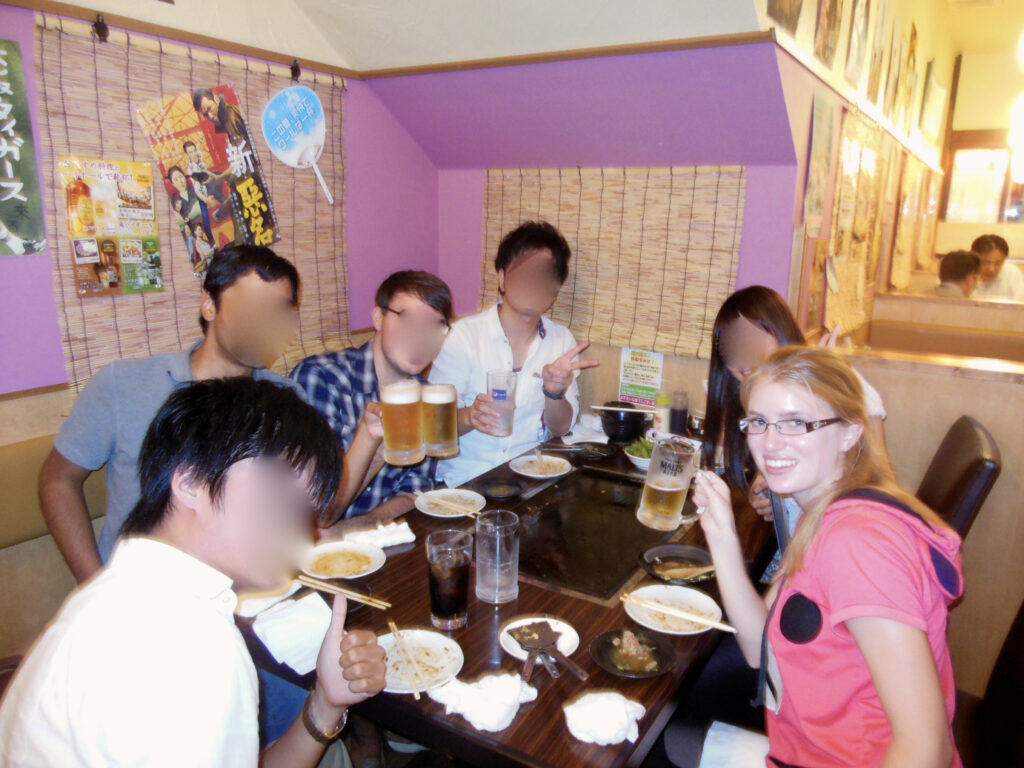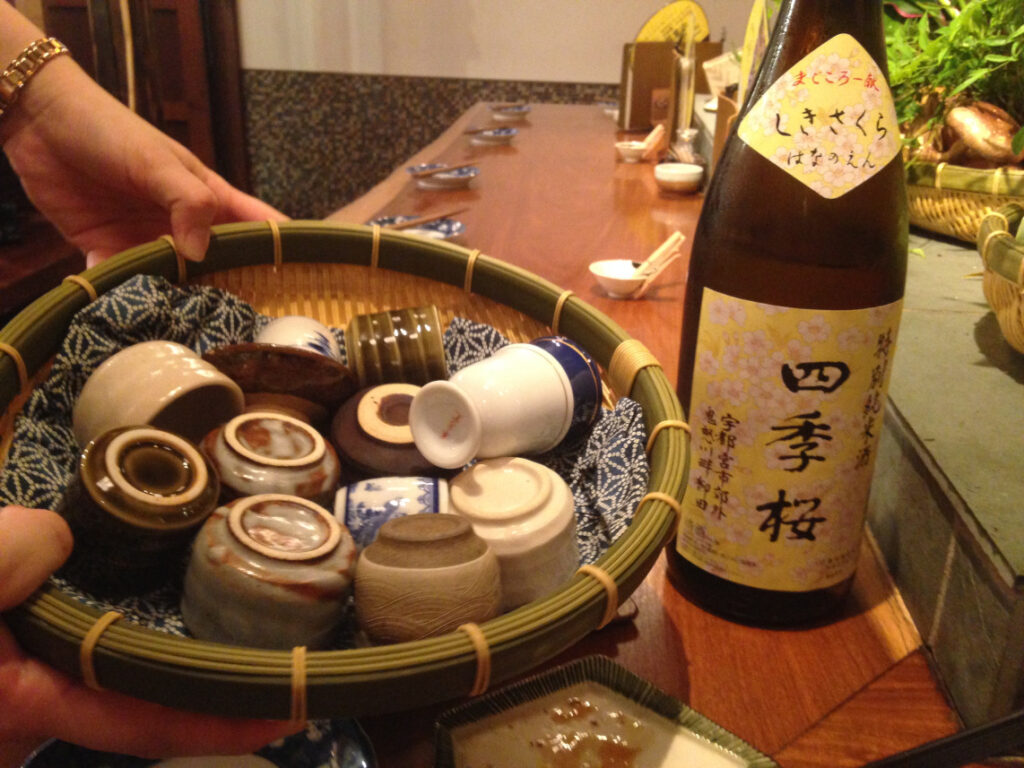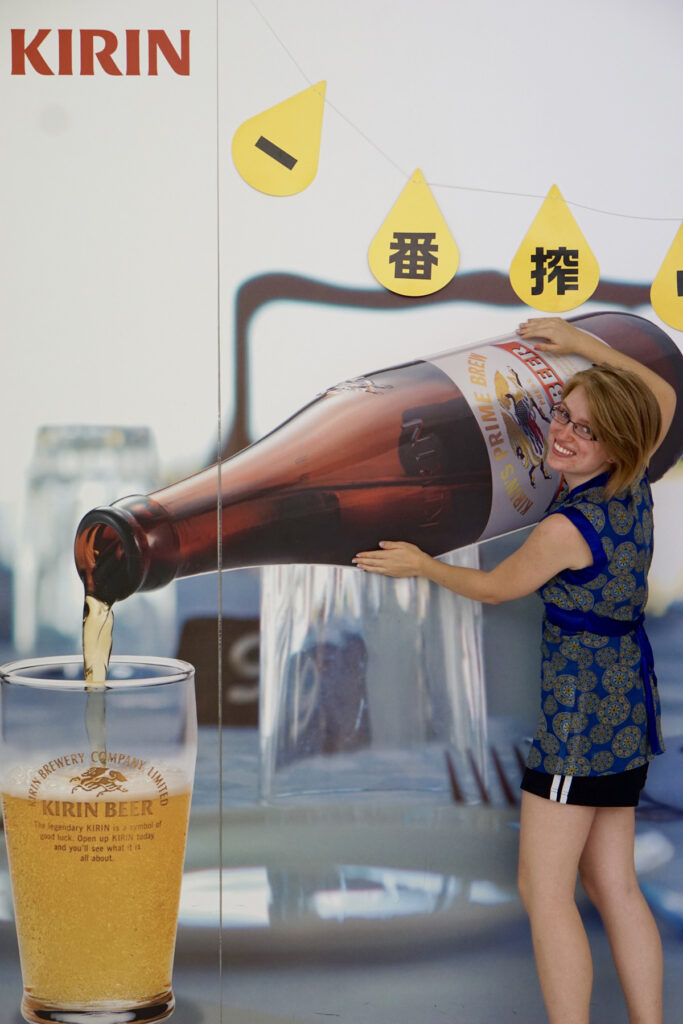Whilst you’re studying Japanese or in Japan, you’ll virtually actually must say “cheers” in Japanese.
It is because alcohol is in all places in Japan, and the Japanese individuals like to have causes to provide a toast!
In Japan, it’s extremely widespread to go to a pub (or izakaya) after work or to fulfill buddies at a swanky new cocktail bar within the metropolis. The truth is, there are even all-you-can-drink specials at many eating places, pubs, and karaoke bars! (Extra on this later, in fact!)
Don’t drink? Don’t fear! There are many options for you, too.
I lived in Japan for a number of years, communicate the language fluently, and can be your cultural information for this text. So let’s dive into the right way to say “cheers” in Japanese and a few consuming tradition and etiquette that may make your folks say, “Sugoi!” (That’s “superb,” by the way in which!)
Japanese Phrases for “Cheers”
Whereas there’s one commonplace phrase for “cheers” in Japanese, you even have a number of choices! Listed below are some phrases you should utilize to boost your vocabulary for various events.

Right here’s me with some college buddies out for a drink in Japan, again within the day!
Kanpai (乾杯): The Go-To Cheers
English: Bottoms up!
Utilization: When everybody’s drinks are prepared, maintain up your glass and be a part of within the refrain of “kanpai!” That is your fundamental, on a regular basis cheers. The phrase actually means “dry the glass,” however don’t fear – no one expects you to down your drink in a single go (until you wish to).
Otsukare-Sama Desu (お疲れ様です): Recognition of Laborious Work
English: Good job at the moment! / Thanks to your arduous work!
Utilization: That is good for these Friday night time workplace events. It acknowledges the hassle everybody’s put in. Think about clinking glasses after a protracted week and exhibiting appreciation to your crew’s arduous work – this phrase provides that particular contact. (Enjoyable truth: That is usually a typical greeting amongst adults assembly after work. They’ll usually say this as an alternative of different methods to say “hi there” in Japanese!)
Alternatively, you might additionally use otsukaresama deshita (お疲れ様でした). That is the above conjugated into the previous tense. Its utilization is much like the earlier one. However with a previous tense vibe, it’s as if the arduous half is over, and now it’s time to calm down. This one’s good because the celebration begins winding down, and also you’re in your previous few drinks, sharing tales of the week’s battles.
Each of those are the formal type of the phrase. If you wish to make it extra informal to make use of amongst buddies and different individuals you share shut bonds with, simply say otsukaresama (お疲れ様).
Omedetou Gozaimasu (おめでとうございます): Celebrating Victories and Milestones
English: Congratulations!
Utilization: Bought one thing to rejoice? A promotion, a birthday, or maybe a buddy’s engagement? That is your phrase. It’s versatile and can be utilized in most joyful events once you’re elevating a toast to excellent news.
Omedetou gozaimasu is the formal type of this cheers. To make use of it in informal settings, you may simply say, Omedetou (おめでとう).
Banzai (バンザイ): A Cheer with Historic Roots
English: Reside 10,000 years!
Utilization: That is greater than only a cheer; it’s charged with historic spirit. However be cautious with this one: it could actually have navy connotations because it was used as a warfare cry in help of the Emperor. You in all probability gained’t come throughout this one all an excessive amount of, however you may see it used throughout moments of excessive pleasure or in very vital celebrations.
Dos and Don’ts of Consuming in Japan
Okay, so now we all know some issues to say throughout toasts in Japanese! What else ought to we do to combine ourselves into Japanese consuming tradition?
In case you’re simply grabbing some drinks with buddies, it’s far more informal and versatile. However in case you’re going out consuming in a proper setting, akin to with coworkers or at a enterprise dinner, you’ll need to concentrate on this etiquette!
- Do Order the Identical First Drink: It’s all about unity. Beginning with about identical drink, often beer or sake, is seen as a nod to group concord. Extra virtually, it makes the server faster in delivering your drinks so you may all toast and begin consuming extra shortly. You’ll often be given a alternative, akin to beer or oolong tea, so simply select which one strikes your fancy within the second. You will get no matter you need later.
- Do Anticipate the Toast: Don’t begin sipping (or chugging, I’m not judging) earlier than everybody’s drinks are delivered, as a result of there may be a fast toast! Gauging the second earlier than everybody sips is essential. If doubtful, see what everybody else is doing.
- Do Pour for Others: Particularly in the event that they’re older or of upper social standing. It’s a means of exhibiting respect and constructing camaraderie. Pour for your self final.
- Don’t Fill Your Personal Glass: Let another person do it, and be able to return the favor. In case you’re accomplished consuming, go away your glass full so nobody is tempted to pour extra for you.
- Don’t Toast with Water: For goodness’ sake (or sake‘s goodness), by no means toast with water. It’s related to rituals for the departed and generally is a large fake pas. Persist with non-alcoholic choices in case you’re not imbibing.
What to Drink in Japan
Whether or not you drink alcohol or not, you can provide a cheers in Japanese with quite a lot of drinks! Listed below are a few of the hottest ones.
Common Alcoholic Drinks in Japan
Nihonshu (日本酒)
Generally known as “sake” outdoors of Japan, this rice wine is each conventional and versatile. It may be loved heat or chilly, and pairs superbly with a variety of Japanese dishes.
Enjoyable truth: Nihonshu (日本酒) actually means “Japanese alcohol,” and sake (酒) (pronounced “sa-kay,” by the way in which, not “sa-kee”) is a generic phrase for any kind of alcohol. You’ll discover the kanji character is similar, though the pronunciation is completely different!
Keep in mind, you’ll be served sake in a small glass paying homage to a shot glass, however completely don’t down it in a single go! Sake is brewed like a beer, however sipped like a wine.

Sake will are available in a bottle, however you drink it in tiny cups!
Beer (ビール)
Beer (biiru, ビール) is immensely fashionable in Japan, with native brews like Asahi, Sapporo, and Kirin main the cost. It’s usually the drink of alternative initially of a night out. The usual beer in Japan is the lager, and in my view, they’re all fairly good!
Shochu (焼酎)
A distilled spirit usually stronger than sake, shochu is comprised of elements like barley, candy potatoes, or rice. It may be loved neat, on the rocks, or blended with water or flavored drinks. (I usually liken it to Japanese vodka.)
Umeshu (梅酒)
This candy and tangy plum wine is a favourite amongst those that favor one thing on the sweeter aspect. It may be served by itself or with soda for a refreshing spritz.
Whisky (ウィスキー)
Japanese whisky (wisukii, ウィスキー) has gained worldwide acclaim in recent times. Take pleasure in it neat, with a splash of water, or as a highball blended with soda.
Common Non-Alcoholic Drinks in Japan
Amazake (甘酒)
A conventional candy drink comprised of fermented rice, amazake is usually alcohol-free and often consumed at festivals or as a wholesome winter hotter. Generally it does have a low stage of alcohol in it, although, so be careful if that considerations you.
Oolong Tea (ウーロン茶)
Oolong tea (uulon cha, ウーロン茶) is a traditional non-alcoholic possibility that’s nice for these wanting to hitch in with the rounds however not drink alcohol.
Calpis (カルピス)
Calpis (karupisu, カルピス) is nice and tangy milk-based beverage you may take pleasure in straight or blended with soda for a fizzy deal with.
Mocktails and Non-Alcoholic Beer
Many Japanese bars at the moment are providing artistic mocktails, permitting non-drinkers to benefit from the flavors of fashionable cocktails minus the booze.
And sure, non-alcoholic beer has existed in Japan lengthy earlier than it turned fashionable within the West! You’ll be able to nonetheless clink cans of zero-alcohol beer with your folks, and no one’s the wiser.
To search out non-alcoholic variations of fashionable drinks, ask for noo arukooru (ノーアルコール) choices.
Safely Navigating: Japan’s Consuming Legal guidelines
On that be aware, let’s discuss consuming legal guidelines in Japan. These may be considerably acquainted if you’re, say, British, however very completely different if you’re American. Listed below are some issues to notice:
Japanese Consuming and Driving Legal guidelines
Japan is strict about consuming and driving. Simply don’t do it. Basically, consuming and driving in Japan is classed as having even a swig of alcohol and driving a automobile or driving a bicycle (sure, you heard me proper!). Right here’s the lowdown:
- Zero-Tolerance Coverage: In case you’re driving in Japan, even a tiny quantity of alcohol in your system is an enormous no-no. The permissible blood alcohol content material (BAC) is nearly zero (0.03%, to be precise), so it’s greatest to both not drink in any respect or plan different transport. That is one motive why non-alcoholic choices are so fashionable.
- Extreme Penalties: Getting caught consuming and driving in Japan can result in extreme penalties, together with heavy fines, jail time, and even lack of employment. It’s a severe matter, so all the time maintain it in thoughts after any merry gathering.
- Daijoubu Driver: In case you do end up needing to get house after a number of drinks with out public transportation choices, think about using a daikou (代行) service — a substitute driver who takes you and your automobile house safely. It’s a broadly used and much-appreciated service in Japan that helps everybody keep secure on the highway. After all, you can even name a taxi or an Uber as properly in case you don’t want to select up your automobile later.
Japanese Public Consuming Legal guidelines
Japan has a reasonably chill method to public consuming in comparison with another international locations, but it surely’s nonetheless all concerning the context. So, whether or not you’re planning a hanami picnic beneath the cherry blossoms with a calming can of biiru or hoping to take pleasure in a swig of sake by the riverside, right here’s the lowdown on Japan’s public consuming legal guidelines.
- No Open Container Legal guidelines: Japan doesn’t have open container legal guidelines like some international locations do. This implies you may legally take pleasure in a drink nearly wherever outdoors your favourite izakaya or sake bar.
- Public Locations Are A-OK: Parks, streets, and even some public transport areas don’t frown upon the informal drinker. It’s not unusual to see of us toasting away throughout out of doors festivals or having fun with a chilly one on a leisurely bench.
- Respect Is Paramount: Simply because you may drink in public doesn’t imply you ought to be swinging from the lampposts. All of it circles again to respect—a central tenet of Japanese tradition. Be conscious of your environment and the individuals round you.
- Nighttime Nuances: Whereas day-drinking in public might be fairly lax, typically native guidelines may tighten up after darkish. Sure areas, particularly in leisure districts, might need their very own tips or curfews for consuming in public to take care of peace and order.
- Occasion-Specifics: At live shows, sports activities occasions, or festivals, comply with the vibe and the foundations. Some will permit consuming; others gained’t. Go searching, see what others are doing, and when doubtful, ask —a easy Nomimono wa daijoubu desu ka? (飲み物は大丈夫ですか, “Is consuming allowed right here?”) will do the trick.
- Comfort Actuality Verify: Ever observed these chilled alcohol sections in Japanese konbini (comfort shops)? They aren’t only for house use. It’s completely regular to seize a drink there and revel in it outdoors, so long as you throw away your trash the place it belongs.
Nomihoudai (飲み放題): Japan’s All-You-Can-Drink Phenomenon
Okay, so we’ve gotten by means of the authorized bits–now for a enjoyable half!
Nomihoudai (飲み放題)–usually written as “nomihodai,” alternatively–interprets to “all you may drink,” and it’s precisely that—a set worth for limitless drinks over a set time interval, often two to 3 hours. You might be often given a particular menu of what you’re allowed to select from (these often embody beer, white and pink wines, sake, a number of fundamental cocktails, and some non-alcoholic choices), and also you order your drinks from the server. It’s nice for teams and partygoers in search of a cheap method to take pleasure in an evening out.
Many izakayas (Japanese pubs) supply nomihoudai as a part of their service. It’s a incredible method to strive completely different drinks with out worrying concerning the invoice racking up.
Simply because it’s all you may drink doesn’t imply it ought to be all you may abdomen. Tempo your self and know your limits to keep away from any damaging penalties — akin to a tricky morning after or getting too rowdy in a tradition that values decorum. To be trustworthy, I’ve gotten extra badly drunk in Japan than wherever else in my life thanks to those.
You may as well often mix a nomihoudai with a tabehoudai (食べ放題), or an “all you may eat.” It is a nice method to check out quite a lot of Japanese dishes. Some locations supply each to make an final eating expertise the place you may savor limitless dishes alongside a seemingly infinite river of drinks.
Kirin is likely one of the hottest beer firms in Japan. However they don’t often come this large!
A Toast to Language Studying
So, there’s your crash course on “cheers” in Japanese!
Embracing these phrases and actions isn’t nearly having fun with a drink; it’s about connecting deeper with a tradition that values subtlety and shared experiences. And who is aware of? Perhaps the next step is to select up a number of extra Japanese phrases and deepen your understanding of this wealthy language.
So, prepared your glass, apply your greatest kanpai, and right here’s to Japanese language and tradition – could they all the time be as pleasant as a well-timed toast amongst buddies! 🥂



